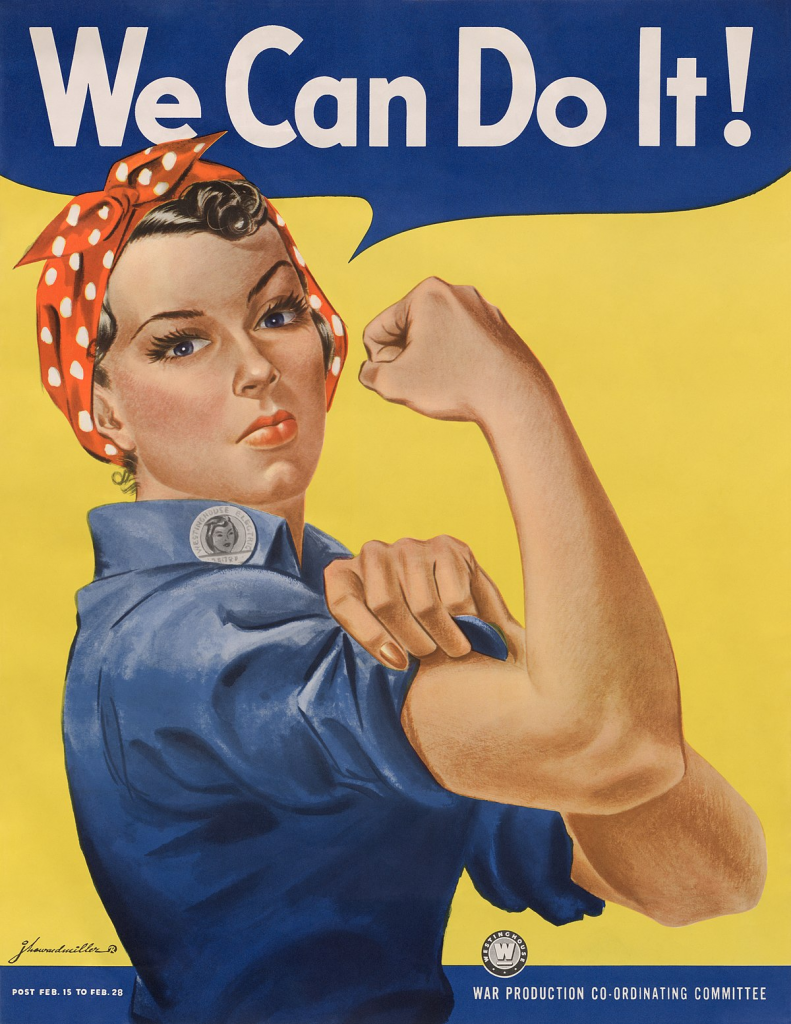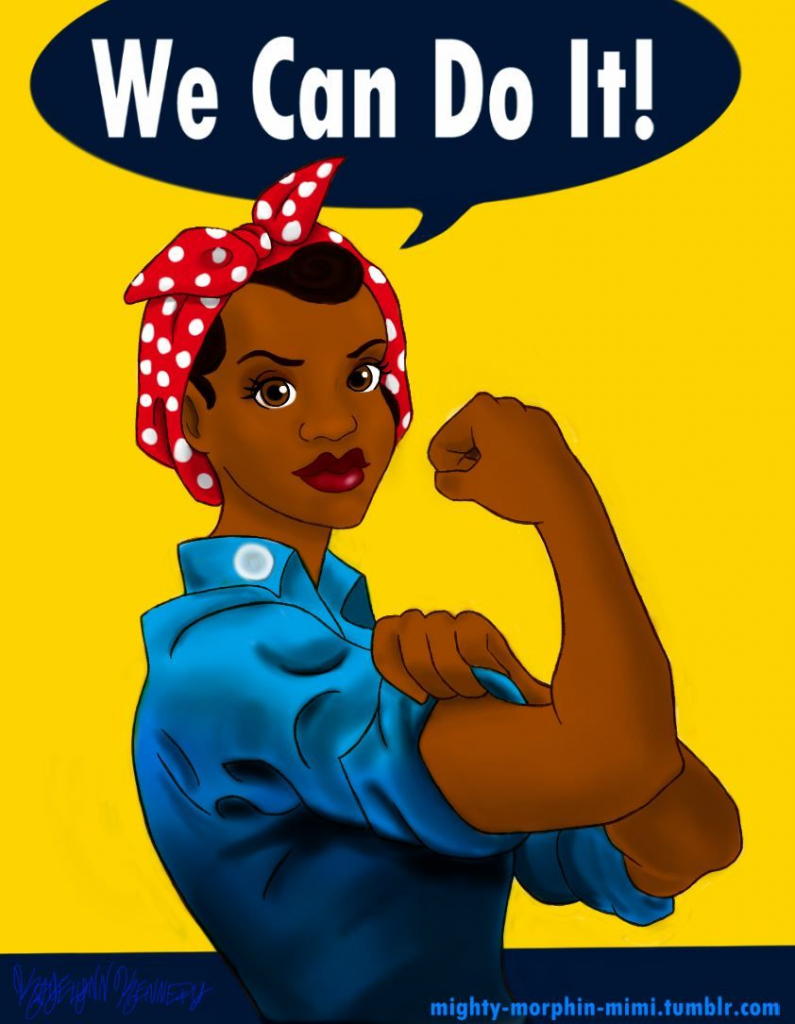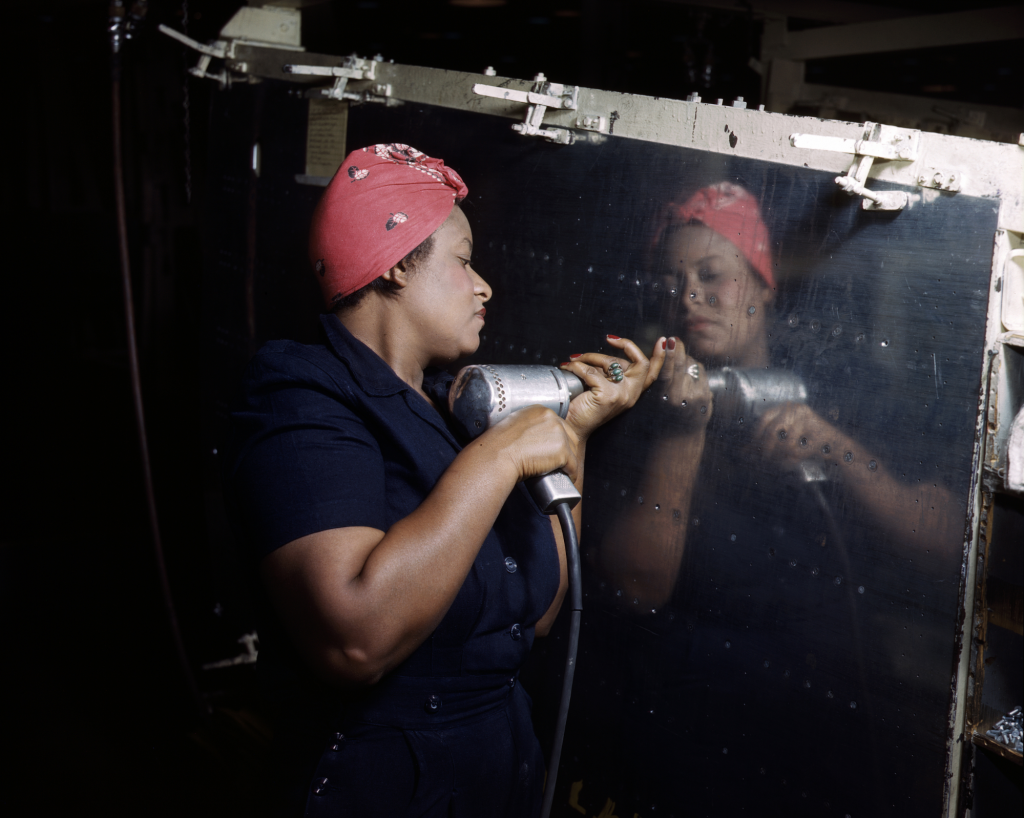While marketing books sure are a great way to get action plans for growing your business, inspirations for new you campaigns and ideas for reaching new audiences, sometimes it’s the books outside of this genre that can really have an impact and inspire you.
Such was the case for Talia, when she was reading Rosie Reveire Engineer to her 3yo.
In this episode we unpack the campaign behind the We Can Do It poster we all know and see so much, and breakdown the ways you can choose images that will inspire people into action.
The transcript
Ross: So typically when I’m trying to get inspiration, I always rely on marketing books. What about you? Do you typically read like business books, nonfiction, et cetera, to kind of get inspired?
Speaker 1 (00:41):
Talia: Definitely. I’ve been reading a ton of books lately just to kind of get some ideas and inspiration.
Ross: Same. Like for me, I’ve read all of the various, like many books from Seth Goden. I’ve read all of the massive books, like principles, the hard things about hard things. I will teach you to be rich by Rameet SETI, like atomic habits, James Clair, all those stuff. And I read them so often that I often forget that there’s entire other genres out there that you can read. But a few weeks back I came across a book that kind of just shifted my thinking a little bit. It was a book called snow crash and it’s a science fiction book. And it talks about like what the world could look like. If essentially when we died, we were able to upload our mental, like thinking and perspective to the cloud. And it just took me down an entire rabbit hole of the power of automation, the power of AI and how things could be operated a little bit smoother.
And it ultimately resulted in me starting to implement a whole bunch of new automation processes within my company and with my own day to day work, trying to kind of get ready for this whole future. So I think one thing that we often make the mistake of doing is just stay in our lane in terms of books. But I think you can get inspiration from books that are outside of the typical John Braze, like business and things like that. I’m sure you’ve been there as well. Tell me a bit about like what you were talking about earlier around kind of the fact that you’ve been reading some children’s books and we’re able to actually get some inspiration for today’s episode directly from there.
Talia: Yeah. So funny. Um, yeah, I was reading the book, Rosie Revere engineer it’s by Andrea Beaty and I was reading it to Rio who’s free and it’s actually become our favorite book. The entire series of her books is phenomenal. She’s just writes incredible books, but this is a story about young Rosie. She is, um, in the book, I think she’s six or seven. Um, actually she’s second grade. How old are your kids in second grade?
Ross: It’s seven, maybe six. I don’t know. It all blends in. That’s what I’m realizing.
Talia: So Rosie, as she was growing up, like when she was two and three and four, she was trying to solve problems with her inventions. So she was kind of this self starter engineer and she was shy and she was quiet. And she didn’t to tell anyone about this dream of becoming a great engineer because many times throughout those years, as she was growing up, people, including her uncle and her family laughed at her. So she was kind of building things like in a hideaway and in her room quietly, really amazing. But then what happens is when she’s eight or nine grade two, whatever that is how a great, great aunt Rose shows up and she’s wearing the famous red polka dotted scarf that we know of as Rosie the Riveter. And it turns out that Rose used to build airplanes during world war two. She was an engineer, a mechanic.
And as you read this book, you actually see the, all the illustrations and the book are actually various planes that women build all of that, including Amelia Earhart. And it’s all based. This entire book is actually based on the, WE CAN DO IT poster at the back of the book. It also talks about the whole idea of Rosie, the Riveter, and the women worked really hard and essentially took over the workforce during world war two. And this led me down, as I said, like a rabbit hole of what is this poster that we can do it post? Where did it come from? How has it stuck with us since world war two? How has it still used in so many protests and everything to do with women’s rights till this day? And actually when I looked into it, I found out that there’s a ton of lessons that we can learn from this specific poster and can apply it to today’s marketing and everything that we do.
Ross: Amazing. I love it. I’m looking forward to diving into this one. I’ve always seen the, we can do a poster and it is completely without question been an inspiring visual for, I think, all walks of life. Um, even some of the remixes of that poster where you start to see people of color kind of becoming Rosie the Riveter there’s iterations of it, where you can see people of all different backgrounds, just becoming Rosie the Riveter and like holding up their arm and their bicep showing like I’m strong. And it’s an amazing visual that has lived in kind of continued to live as an amazing kind of rallying cry around this whole idea of we can do it.
Talia: Yeah. There’s even one of Beyonce. I don’t know if you know this, but I’m going to post it. I’m going to post it on my website so people can see it, but it really has. It’s, it’s rooted deep in all of our history and it has an effect on us till this day. So that’s kind of take a step back and look at it.
Rosie the riveter story
So back in world war two, the American government distributed hundreds of photos of women working in factories all over the media. So essentially everywhere you looked on posters and TV ads, you’d see these photos and images of women and they’re working. And this campaign was designed to encourage millions of women to work in the industry and take over jobs previously owned by men and encourage them to volunteer for wartime service in factories. Now, since men were shipping out to war, the country needed women to replace them and fast.
So these photos that they were distributing were of women building and fixing aircraft, creating ammunition, assembling bombers, and working the actual production lines, these images, I mean, they are phenomenal. And I love them so much. Again, I’m going to be posting these all on our website, cause you guys have to check this out and what’s extremely powerful about this campaign. And these images is that following this campaign more than 6 million women go wool jobs in world war two. Now later, when the war was over the United States government basically sponsored propaganda to urge women to go back home. Uh, but as you may have noticed till today that didn’t really work, which is a good thing. Um, so this was the start of something bigger and the feminist movement, as we know it today was inspired by this Rosie, the Riveter by this weekend, do a poster.
Why this campaign worked so well
Talia: What I want to talk about today is how they did it and why did it work? So, and that actually has a direct impact on how you choose images. So if you are a marketer or a founder and your work today is to choose images for your landing page or maybe a Facebook campaign, or even the hero image of your website, this campaign can actually really give you some inspiration on how to choose images. And this is actually why it worked so well because the biggest part of why it works so well was the imagery because it was real, it was inspirational. And most importantly, it allowed women to see themselves. And that’s one of the most high combating things. When people see people, they relate to people like them, it converts the other thing that worked pretty well here was the call to action. They inspired confidence and met women where they were, they used copy that really singled out what they were doing and made them feel confident in their ability to become mechanics and to work in factories. And part of the copy, like some of, some of the examples of the copy that they used was incredible.
Can you use an electric mixer? If so you can learn to operate a drill.”
You know, women felt proud that they could support that country and their family. So everything about, um, the words that they were using, meeting people where they were and using inspirational imagery was great. So I was, it was really amazing to look at and even looking at it today. I don’t know if you seen any, um, images like this before Ross, that kind of you look at and you go, yes, like this is me, this is relatable. I get it. The copy, you know, really speaks to me and yeah, makes me want to take action
Ross: A hundred percent. Like I see this, um, done very well by brands who actually spend the time to put themselves in the shoes of their customer. Right. I think often times brands just create content and they hire agencies to create content or tell stories, et cetera. And the stories just speak to the people around the boardroom table rather than the people they’re trying to reach. I think the thing that they did well with this, even though it could be considered kind of like the propaganda style is they really spent the time to understand who it was. They were trying to reach and create a story and a narrative that would resonate with them.
Using images as directional cues
Ross: A subtle thing that is also important to notice in the imagery is the eyes in this image are looking directly at you, right? I think by it, by the woman looking directly at you in this ad and in this creative, you’re able to say, okay, like she’s speaking to me, she’s speaking to me as an individual.
And I now need to take action. People underestimate the importance and role that the eye placement and where somebody is looking has in their creative, whether it’s a landing page, whether it’s an ad, et cetera, the eyes and the placement in which those eyes are directed actually has a real massive impact on how people perceive the content surrounding the graphic. And if that graphic in that image is looking directly at you as the viewer, you know, and you feel like they’re speaking to you as an individual versus speaking to someone else who may be a third party. So I think you’re right in the sense that the imagery is great. The CTA is great, but the most important thing that they did is they made it relevant to the person who was looking at it at that time to make it connect with them.
Talia: I love your point about the eye contact because now I’m the last person to advocate to do these kind of button testing and stuff. But there have been hundreds of tests run on landing pages where you can literally see that when a person is looking directly at you, or if a person is looking directly at the call to action, or if they’re pointing at it, there is more conversions because you’re telling them what to do. All eyes are looking for what to focus on when we’re pointing at something. Or if you have people even just with their eyes, looking towards a call to action button, you’re going to be looking to that direction too. So the point about having someone stare you straight in the face and say, we can do it is really more personal looking you into your eyes and saying, you can do this too. Like, it’s not just me. Anyone can do this and I’m speaking directly at you. So I love it.
Ross: Yeah, no, it’s so true. So when we look at this and we consider all of the various factors, I think there’s a lot that people can take from this in terms of how they can implement it with their marketing, how they can implement it, even with just simple creative assets as individual creators. But if we were to take a step back and say, okay, from a holistic level, what can I do now? Now that I’ve understood kind of the impact that this simple piece of creative has had? How can I improve my creative? How can I improve my strategy? How can I be a brand that is more authentic and connect with people on an emotional level and really leverage this piece as an inspiration for what I can do moving forward to be a better marketer, what can we use and what can we do to leverage this idea and this approach to kind of create a better strategy, what would be in your opinion, like the best place to start.
How to create images that inspire action
#1 Review your current images
Talia: So, as I mentioned at the beginning, you can use the strategy to really create imagery. That inspires action. So the first thing I would encourage you to do is to review the current imagery that you have on your ads, on your landing pages, in your campaigns, does it highlight the customer or yourself? What is happening on the images? Is it images of your product or is it images of the people using your solution? Are you focusing on the desired outcome that people are going to achieve? Or are you focusing on how people are feeding right now examine the current imagery? What does it look like? What do your images you should include? Are you making it about your product, your pricing, your features, are you making it about what your solution looks like on different devices? Well, are you giving, are you using an image that can actually inspire people where people can see themselves in it? And I think that’s the first thing you want to do is examine what you already have.
Ross: A hundred percent. I love that. I think you’re right. I think that’s where you need to start, because you can only figure out where to go from there by reviewing and analyzing what exists today and your current kind of standpoint. I love that. Great, great tip.
#2 The type of images you want to use
Talia: Next, what you want to do is start thinking about the type of images that you want to use. So this means using more inspirational, authentic, relatable images. So I recommend dropping the stock photos. And what I mean by that is, is obviously most of us yeah. Are going to use a stock photo of a sort. Now, if you can get real images of people, and that means either people in your office, your audience, your existing customers, your existing clients, people that are really using your solution, that would be amazing. But if you can’t do it right now, if you don’t have the resources for it, I would urge you to look into websites that aren’t specifically directing you towards those stock images. We all know these types of images I’m talking about that they don’t feel real. They’re not authentic. They’re plasticky. If that makes sense.
Ross: Yep. No, that’s fair. We’ve all seen those images. We seem the ones where it’s like every single person, every single startup is using the exact same image of somebody with a suitcase or that of people sitting around a boardroom table. And they’re all wearing gray suits. We’ve all seen those plastic shots a hundred percent. I agree. But yeah, continue.
Talia: You know what? I also want to add to that because it’s driving me nuts, these character images that everyone’s using now in the software business, I think you and I have had this conversation where everyone just looks the same. Like we’re using these abstract images of people on the page. I think notion is using them now and Canva, I’m not here to call out certain companies because they’re doing a great job. Like I use Canva all the time and notion, but there’s like this mainstream of software companies that are now using really weird things. People are triangles and there’s no nose. And there’s like half a nose. I dunno. It’s really weird.
Ross: It’s true.
Yeah. It’s definitely a consistent trend. Like I think even on the foundation side, we’ve got a few of these characters, but no, I hear you 100% get it. Like I wrote a piece of both the rise of these illustrations a while back saying everybody is starting to kind of look the same with their creative in their approach. And I think the reason why people don’t embrace as much authentic like images and photography is because of the costs. And I think sometimes people are afraid that if someone leaves their company, can they still use that image, et cetera. But I think it’s honestly a worthwhile investment to put in the time to create that authentic photos and create some content that, or capture that content that speaks to your brand’s values and your brand’s purpose and the people on your team, et cetera. I am 100% with you.
I think the, the rise of the illustration photos while it has without question, um, kind of wipe it completely through the world of SAS and software and things like that. There’s still a better option and that is using real photos. But the one piece I would also say is whether it’s real photos or if it’s illustrations, don’t hold yourself to even just that, like, there’s an ability to think, even beyond that, with things like video, there’s the ability to think beyond that with maybe a three dimensional, um, animated video of some sort where you can use CGI or something like that. Like I think the opportunities are endless, the only limit is creativity, but to bring it back, um, I think you’re right. Let’s use real authentic images as much as possible drop the basic stock. We could probably create a hierarchy of like, what are the best types of images and create a bit of a pyramid. And at the bottom of like the thing that you shouldn’t do, but it’s okay if you do, but it’s probably, you can definitely find a better option to stock photos. Like at the bottom of the authentic imagery approach is stock.
Talia: One thing I would recommend looking into is Unsplash, I don’t know if you know that website I’d love it. Um, and I just want to point out that I, while I totally understand the th th that some companies don’t have the budget to put into, you know, hiring a camera person I’m really coming in and doing and filming like these crazy 3d shots and stuff. We live in a world where we all have an iPhone or, you know, a very, very smart phone in our pockets, which is basically a computer. And we don’t need that anymore. I have seen countless videos and images on websites that people took with their iPhones that took there with the Androids and they look great. And actually that, that kind of contributes to that authentic, real experience where it’s real people, because we can all look at a website and tell when it’s just something that someone bought and placed on that, on that website.
And back to those illustrations. The reason I believe that everyone kind of looks the same and this was happening before the illustrations too. It’s kind of like the blind leading the blind, I think pebble ISDN at this a while ago where we don’t really know what to choose. And we look at our competitors and we’re like, they must know what they’re doing. And yeah, but most of us don’t. And I think that when everyone kind of follows a trend at ends at some point, and you’re left with no real insight. And while I know that not everyone can, you know, take those authentic images, you can still go onto websites like Unsplash, and there are so many more and get some ideas for the different types of images that you want to use. I urge you to really dive in and think about it. Who is the person behind the screen?
And if you were to put a photo of them on the website, who are they, what do they look like? What are they feeling? Where are they sitting? What are they drinking? What are they eating? How are they feeling in terms of I’ve now used the solution? Or how are they feeling right now before finding a solution? And there’s just so many different ways you can go. But at the end of the day, you want to use relatable images. You want people to be able to see images of people like them. And, you know, in the past, if you go back to the nineties brands like Nike were using Michael Jordan and other re famous athletes for you to aspire and say, Oh, I want to be like Michael Jordan. So I’m going to get these shoes. But these days, when you look at Nike, you don’t use as much, uh, celebrity athletes as they used to. And they’re using more images of people like us, people that just go on a run that people who are just kind of going to the basketball basketball court to blow off some steam or whatever it is, you can see the trend of these brands that have gone from having the budgets to spend millions on these famous people, go back to the quote, the little person sitting at home who isn’t, you know, an NBA player.
Ross: So true. And there are tons of these sites where I think, I think one of the coolest things about the internet today is the fact that you can kind of get crowdsourced content through sites like Unsplash, um, and a few others that I want to just give a shout out to. So our listeners can kind of go down a path and find some of these creative sites where you can get great and better stock photos and stock content.
- Pexels – They’ve got an amazing platform with tons of creative content. Um, there’s one called death to stock photos.com. It is a paid subscription, but it’s all artists like there’s a co op and essentially every month that you’re subscribed, um, a portion of the money goes to the various artists who are contributing their content. And this is content that you’re not going to see on a bunch of other sites, because there’s only a small number of people who are subscribed to them.
- Mix it – That’s specifically has like a lot of templated stock videos that you can use.
- Nappy.co – And one that I came across just recently, which is dedicated to kind of having, um, black people and Brown people in their content, because that’s rare in stock photos is a site called nappy.co. It’s filled with just amazing photos, again, of people that are black and Brown. So I think there’s a lot of great resources and the more you can find these niche sites, the better you’ll be able to find authentic content that nobody else is using.
Talia: That’s brilliant. There is so much to say for actually paying to get those authentic images, and it’s not, um, you know, at the end of the day, it’s not going to be break the bank kind of budgets. It’s a couple of dollars a month in order to get those images. And of course, making sure that you’re choosing images that RJ verse and actually represent who your customers are and your users is super important and not just portraying yourself or the specific people that you have in your mind, but everyone. So I love that exactly.
Ross: A hundred percent. Okay. So let’s get back to kind of figuring a, what can folks do with this strategy. We’ve done a lot of talking around, um, the different types of creative, the different things to look for when you’re picking your images. What else can folks do to kind of ensure that when they’re telling their story, they’re trying to get it out there, that they can actually knock it out of the park with their approach?
#3 Testing your images
Talia: Well, I think the, the best thing is to test it, right, test your different ideas for images, and think about how you can leverage imagery to inspire people, because I’m going back to why people buy products, why people buy solutions at the end of the day, we buy anything to become a better version of ourselves. So what does your solution offer? Because even if you are an, and these are examples, I give quite a bit, but when you buy a tee shirt, what you’re buying is self esteem. When you buy insurance policy, you’re not buying a piece of paper, you’re buying peace of mind. So what is the better version of your customer? Ask yourself, can you use imagery to really inspire people to start a revolution? You know, you and I had a episode about this on inspiring people and, and kind of competing in inspiring a movement or revolution or protest, and, you know, revolution isn’t necessarily the me too movement.
Sometimes it’s just the different changes in our lives that we can make. Um, we can change our belief system or the way we feel about ourselves. So your images can do that. It can inspire them a confidence. It can shift the way we think about ourselves or other people. We want to make sure that we’re using powerful imagery that supports our copy, the strategy and the message that we’re trying to make, because you can write amazing copy, but if it isn’t supported with the right imagery and colors, you’re not going to get too far. So that’s kind of, that’s what I would suggest.
Ross: Yeah. I love that. I think the idea of always testing things and trying to figure out exactly what resonates with your audience while staying true to your brand and your story, and what you’re trying to get across is 100% spot on in terms of the approach that folks need to need to take, as they start to think about, like, what is the story that we want to tell, what is the message that we want our audience to kind of resonate with and use to kind of figure out how they can in fact improve their lives because of the content and the stories that you’re telling. So I think that’s a great place to even wrap this up, but before we do, is there any other last comments that you think our listeners should hear in regards to the, we can do a campaign?
Talia: You know what, I’m just going to say that everyone should read Andrea Beaty’s stories. I’ve been pushing them on Roth for like a few weeks now, because what’s amazing about this entire series of books is that it’s so diverse, so inclusive, so authentic and amazing. Um, from Iggy Peck architect to Rosie Revere engineer and her latest book, Oh, there’s added twist scientist. And her latest book is Sophie Valdez, a future pres each one of them is amazing. And if you have kids, I really encourage you to read them and read them to them. Um, cause I really do believe that they can inspire a better world, um, and more, um, more inclusive world. So that would be my final thing.
Ross: I love it. They are in my cart and I’m a boat to swipe. So let’s, uh, leave it with that. This has been a very important episode and we’re so excited to kind of have you following along on our journey as we create this podcast, don’t forget. Please give us five star reviews on whatever channel it is that you are using to listen to this. And also don’t forget to join our Facebook group. We would love to connect with you one to one, facebook.com/groups/action driven podcast. It would be awesome to see you in there have an awesome day and we will see you next time.







